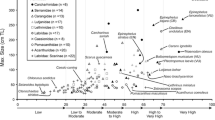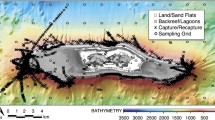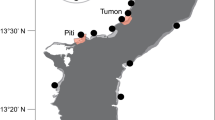Abstract
No-take marine reserves (NTMRs) provide hope that local carrying capacity may be partially restored if reserves are protected long enough. How long is long enough? We assess the duration of protection required for populations of large predatory reef fish in marine reserves to attain new steady states. We monitored biomass of large predatory fish in two marine reserves at Sumilon and Apo Islands, Philippines, almost annually for 26 years (1983–2009), and fit a logistic model to the data. As duration of reserve protection increased, biomass of predatory fish approached an asymptote, although the models suggest that 20–40 years of protection is required to attain new steady states. Thus, for local carrying capacity to be rebuilt, no-take protection must be effective on decadal timescales.

Similar content being viewed by others
References
Babcock RC, Alcala AC, Lafferty KD, McClanahan TR, Russ GR, Shears NT, Barrett NS, Edgar GJ (2010) Decadal trends in marine reserves reveal differential rates of change in direct and indirect effects. Proc Nat Acad Sci USA. Published ahead of print. doi:10.1073/pnas.0908012107
Claudet J, Osenberg CW, Benedetti-Cecchi L, Domemici P, Garcia-Charton JA, Perez-Ruzafa A et al (2008) Marine reserves: size and age do matter. Ecol Lett 11:481–489
Côté IM, Mosquera I, Reynolds JD (2001) Effects of marine reserve characteristics on the protection of fish populations: a meta-analysis. J Fish Biol 59(Suppl A):178–189
Halpern BS, Warner RR (2002) Marine reserves have rapid and lasting effects. Ecol Lett 5:361–366
Hutchings JA (2000) Collapse and recovery of marine fishes. Nature 406:882–885
Jackson JBC et al (2001) Historical overfishing and the recent collapse of coastal ecosystems. Science 293:629–638
Jennings S (2001) Patterns and prediction of population recovery in marine reserves. Rev Fish Biol Fish 10:209–231
Molloy PP, McLean IB, Côté IM (2009) Effects of marine reserve age on fish populations: a global meta-analysis. J Appl Ecol 46:743–751
Osenberg CW, Sarnelle O, Cooper SD, Holt RD (1999) Resolving ecological questions through meta-analysis: goals, metrics, and models. Ecology 80:1105–1117
Osenberg CW, Bolker BM, White JS, St Mary CM, Shima J (2006) Statistical issues and study design in ecological restorations: lessons learned from marine reserves. In: Falk DA, Palmer MA, Zedler JB, Hobbs RJ (eds) Foundations of restoration ecology. Island Press, Washington DC, pp 280–302
Pauly D (1995) Anecdotes and the shifting baseline syndrome of fisheries. Trends Ecol Evol 10:430
Roughgarden J (1998) Primer of ecological theory. Prentice Hall, New Jersey
Russ GR, Alcala AC (2003) Marine reserves: rates and patterns of recovery and decline of predatory fish, 1983–2000. Ecol Appl 13:1553–1565
Russ GR, Alcala AC (2004) Marine reserves: long-term protection is required for full recovery of predatory fish populations. Oecologia 138:622–627
Sobel JA, Dahlgren CP (2004) Marine reserves: a guide to science, design and use. Island Press, Washington DC
Acknowledgments
This project was funded by a Pew Fellowship in Marine Conservation (1999–2002) and the Australian Research Council (ARC) (2002–2010). We thank S Connolly for advice on model fitting, and CW Osenberg and J Claudet for very helpful editorial comments.
Author information
Authors and Affiliations
Corresponding author
Additional information
Communicated by Craig Osenberg.
Electronic supplementary material
Below is the link to the electronic supplementary material.
Rights and permissions
About this article
Cite this article
Russ, G.R., Alcala, A.C. Decadal-scale rebuilding of predator biomass in Philippine marine reserves. Oecologia 163, 1103–1106 (2010). https://doi.org/10.1007/s00442-010-1692-3
Received:
Accepted:
Published:
Issue Date:
DOI: https://doi.org/10.1007/s00442-010-1692-3




